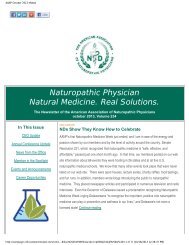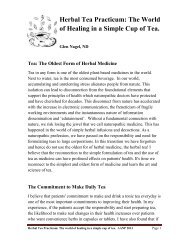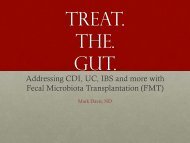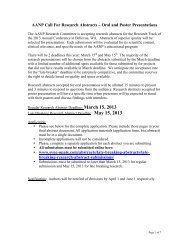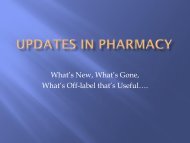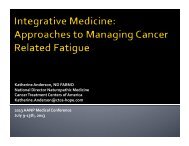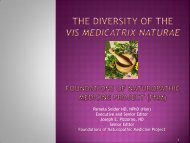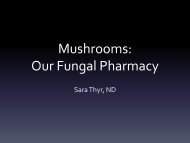Criteria to Meet before Applying Emerging Biomarkers of CVD Risk
Criteria to Meet before Applying Emerging Biomarkers of CVD Risk
Criteria to Meet before Applying Emerging Biomarkers of CVD Risk
Create successful ePaper yourself
Turn your PDF publications into a flip-book with our unique Google optimized e-Paper software.
<strong>Emerging</strong> <strong>Risk</strong> Fac<strong>to</strong>rs for <strong>CVD</strong>:How <strong>to</strong> Assess Residual <strong>Risk</strong>Ryan Bradley ND, MPHAssociate Direc<strong>to</strong>r | Bastyr University Research InstituteCore Clinical Faculty | Bastyr University CaliforniaDirec<strong>to</strong>r | Center for Diabetes & Cardiovascular Wellness
• Assessing <strong>CVD</strong> event riskOverview• Traditional risk classification- Framingham & (now) Reynolds• Residual risk- How much is there?• INTERHEART• <strong>Emerging</strong> risk fac<strong>to</strong>rs- How do you evaluate them?• <strong>Criteria</strong> for evaluating emerging biomarkers• Evaluation <strong>of</strong> select emerging risk fac<strong>to</strong>rs• Lipoprotein measures: Apo B100: Apo A1, particle characteristics (i.e.,number; density; size)• Methylation: Homocysteine, [MTHFR polymorphism]• Inflammation/ acute phase reactants: CRP, fibrinogen [SAA]• Atherosclerosis: Lp-PLA 2 [sICAM-1; IL-6]• Oxidative stress: oxLDL, GGT [f2-isoprostanes, etc.]• Endothelial function: Reactive Hyperemia Index (RHI)• Renovascular function: cystatin C
Traditional Cardiovascular <strong>Risk</strong> Assessment• Framingham <strong>Risk</strong> Score:• Age• Gender• Total cholesterol• HDL• Smoking status• SBP• Resource: http://hp2010.nhlbihin.net/atpiii/calcula<strong>to</strong>r.asp• Reynolds <strong>Risk</strong> Score:• Framingham under estimates risk in women• Reynolds re-classifies risk in 40%• Reynolds adds: hsCRP & A1c (if diabetes)• Resource: www.reynoldsriskscore.org/ 3
Impact <strong>of</strong> adding CRP in women4Mora et al., Am J Cardiol. 2006
Population Attributable <strong>Risk</strong> <strong>of</strong> First MI:INTERHEART<strong>Risk</strong> Fac<strong>to</strong>rs:• Elevated ApoB:ApoA1• OR=3.25 (5th vs. 1st quin);PAR=49.2%• Smoking• OR=2.87; PAR=35.7%• HTN• OR=1.91; PAR=17.9%• Abdominal obesity• OR=1.12 (<strong>to</strong>p vs.lowest tertile);PAR=20.1%• Diabetes• OR=2.37; PAR=9.9%• Psychosocial fac<strong>to</strong>rs• OR=2.67; PAR=32.5%Protective Fac<strong>to</strong>rs:• Daily F&V Consumption• OR=0.70; PAR=13.7%• Moderate alcoholconsumption• OR=0.91; PAR=6.7%• Regular Physical Activity• OR=0.86; PAR=12.2%Total Population Attributable <strong>Risk</strong> (PAR): 90% in women & 94% in menYusuf et al., Lancet, 2004
Contribution <strong>of</strong> Multiple <strong>Risk</strong> Fac<strong>to</strong>rs: INTERHEARTYusuf et al., Lancet, 2004
The Contribution <strong>of</strong> Lifestyle <strong>to</strong>All-Cause Mortality in CAD *• Smoking Cessation:• RR= 0.64 (0.58, 0.71)• Healthy Diet ** :• RR= 0.56 (0.42, 0.74)• Moderate Alcohol:• RR= 0.80 (0.78, 0.83)• Physical Activity:• RR= 0.76 (0.59, 0.98)* CAD= Past MI, Angina, PCTA, CABG** Healthy Diet=Low Sat’d Fat, Regular Fish, Whole Grains, Nuts,F&V, reduced salt (
Contribution <strong>of</strong> Lifestyle: INTERHEARTYusuf et al., Lancet, 2004
• Assessing <strong>CVD</strong> event riskOverview• Traditional risk classification- Framingham & (now) Reynolds• Residual risk- How much is there?• INTERHEART• <strong>Emerging</strong> risk fac<strong>to</strong>rs- How do you evaluate them?• <strong>Criteria</strong> for evaluating emerging biomarkers• Evaluation <strong>of</strong> select emerging risk fac<strong>to</strong>rs• Lipoprotein properties: Apo B100: Apo A1, particle characteristics (i.e.,number; density; size)• Methylation: Homocysteine, [MTHFR polymorphism]• Inflammation/ acute phase reactants: CRP, fibrinogen [SAA]• Atherosclerosis: Lp-PLA 2 [sICAM-1; IL-6]• Oxidative stress: oxLDL, GGT [f2-isoprostanes, etc.]• Endothelial function: Reactive Hyperemia Index (RHI)• Renovascular function: cystatin C
<strong>Criteria</strong> <strong>to</strong> <strong>Meet</strong> <strong>before</strong> <strong>Applying</strong> <strong>Emerging</strong><strong>Biomarkers</strong> <strong>of</strong> <strong>CVD</strong> <strong>Risk</strong>• Measurement provides independent risk prediction notcaptured by current standards/clinical norms.• Treatment is available, validated and unique.• Treatment improves clinical outcomes.• Measurement and treatment are risk-balanced and costeffective.©2013 Ryan Bradley, ND, MPH
<strong>Criteria</strong> Scoring Exercise• <strong>Criteria</strong>:• Met: 2 points• Partially met: 1 point• Not met: 0 points• Weighting based on your values:• E.g., Independent risk prediction & improves clinical outcomes >>unique treatment & risk-balanced and cost effective.• Met: 4 points• Partially met: 2 point• Not met: 0 points©2013 Ryan Bradley, ND, MPH
Overview• Assessing <strong>CVD</strong> event risk• Traditional risk classification- Framingham & (now) Reynolds• Residual risk- How much is there?• INTERHEART• <strong>Emerging</strong> risk fac<strong>to</strong>rs- How do you evaluate them?• <strong>Criteria</strong> for evaluating emerging biomarkers• Evaluation <strong>of</strong> select emerging risk fac<strong>to</strong>rs• Lipoprotein properties• Methylation: Homocysteine, [MTHFR polymorphism]• Inflammation/ acute phase reactants: CRP, fibrinogen [SAA]• Atherosclerosis: Lp-PLA 2 [sICAM-1; IL-6]• Oxidative stress: oxLDL, GGT [f2-isoprostanes, etc.]• Endothelial function: Reactive Hyperemia Index (RHI)• Renovascular function: cystatin C
What properties <strong>of</strong>lipoproteins (LDL) can bemeasured?• Calculated particle concentration (i.e., LDL-C)• Apoprotein concentrations (ApoA, ApoB)• Particle number (LDL-P)• Physical size (nm or Å)• > or < 255 Å• Density• Cholesterol ester content• Triglyceride (TG) content• Oxidation state (oxLDL)
A Few Comments on LDL• 1% reduction in LDL results in a 1-1.7%reduction in event RR 1,2,3• Caveats:• LDL at birth: ~50 mg/dl 4• Estimates <strong>of</strong> LDL requirement for peripheralcholesterol needs: ~25 mg/dl 51. Brown et al, Curr Opin Lipidol. 2006.2. Wilson et al. Am J Med. 1991.3. Pederon et al. Circulation. 1998.4. Brown. Science. 1986.5. O’Keefe et al. AJCC. 2004.
A Few Comments on HDL• Plaque scavenger- “reverse cholesterol transport”• ApoA corresponding lipoprotein• 1% increase in HDL = 1% reduction in risk 1,2• Caveats:• Difficult <strong>to</strong> increase if TG not normalized first• Evidence for drug-increased HDL leading <strong>to</strong> eventprotection is waning (especially when combined withstatins)1. Brown et al. Curr Opin Lipidol. 2006.2. Gordon et al. Circulation. 1989.
ApoB• Apoprotein on lipoprotein micelle, i.e. LDL• ApoB100 vs. ApoB48• B100: hepatic synthesis- endogenously produced LDL &VLDL• B48: intestinal synthesis- packing <strong>of</strong> dietary cholesterolin chylomicrons• Proxy for “non-HDL cholesterol”• Strong correlation with LDL particle number, esp.with normal triglycerides• B100 binds LDL recep<strong>to</strong>r• B48 may not bind LDL recep<strong>to</strong>r
ApoA• Apoprotein on HDL lipoprotein micelle• Strong correlation with HDL particle number
ApoB: ApoA• Elevated ApoB:ApoA1: OR=3.25 (5th vs. 1st quin); PAR=49.2%(INTERHEART)OR (MI)8.04.02.0ApoB: ApoA0.430.721.28Yusuf et al., Lancet, 2004
Unique Treatment?• Lowering LDL lowers apoB100• Raising HDL increases apoA• Lowering triglycerides lowers apoB100 via lowering VLDL
<strong>Criteria</strong> <strong>to</strong> <strong>Meet</strong> <strong>before</strong> <strong>Applying</strong> <strong>Emerging</strong><strong>Biomarkers</strong> <strong>of</strong> <strong>CVD</strong> <strong>Risk</strong>: Apo B: Apo A• Measurement provides unique independent risk assessmentnot captured by measurement per current standards/clinicalnorms• Treatment is available, validated and unique• Treatment improves hard clinical outcomes• Measurement and treatment are risk-balanced and costeffective©2013 Ryan Bradley, ND, MPH
LDL Particle Number (LDL-P)• <strong>Criteria</strong> met:• Independent risk prediction?: Valid and better discriminates <strong>CVD</strong> riskthan LDL-C 1-4 major <strong>CVD</strong> case-control studies and prospective cohortstudies• Treatment improves outcomes• <strong>Criteria</strong> not met:• Unique treatment?: LDL-lowering treatment lowers LDL-P• Independent risk prediction?: Strong correlations with LDL and VLDL(therefore triglycerides), therefore testing less valuable for the costdue <strong>to</strong> high correlation with LDL and VLDL• Cost effective?1. Mora et al. Atherosclerosis. 20072. Kuller et al. Arterioscler Thromb Vasc Biol. 2002.3. Rosenson Am J Cardiol. 20024. Blake et al. Circulation. 2002.5. Otvos. Circulation. 2006.
<strong>Criteria</strong> <strong>to</strong> <strong>Meet</strong> <strong>before</strong> <strong>Applying</strong> <strong>Emerging</strong><strong>Biomarkers</strong> <strong>of</strong> <strong>CVD</strong> <strong>Risk</strong>: LDL-P• Measurement provides unique/independent riskassessment not captured by measurement per currentstandards/clinical norms• Treatment is available, validated and unique• Treatment improves hard clinical outcomes• Measurement and treatment are risk-balanced and costeffective©2013 Ryan Bradley, ND, MPH
Does [LDL-P] Size Matter????
What causes differences in size ?1. Diet: sat’d fat & CHOincrease triglycerides (TG)packaged in VLDLs2. Genes: Cholesterol estertransport protein (CETP)transfers cholesterol esters<strong>to</strong> VLDL (removed from LDL)3. CETP transfers TAGs <strong>to</strong> LDL(removed from VLDL)4. Lipoprotein lipase acts onLDL and…Voilá! small, dense LDLs26#Roheim and Asztalos. Clinical Chemistry. 41(1). 1995.
How many patterns are there?© Berkeley Heart LabsPattern AIntermediatePattern B
What predicts “Pattern B”?• Cross-sectional study <strong>of</strong> 131apparently health adults• Associations with Pattern B?• +non-fasting TGs• -HDLs• Prediction variables• Two-variable model:• HDL and <strong>to</strong>tal TG• Three-variable model:• HDL• Total cholesterol and• Total apoBSwinkels et al. Arteriosclerosis. 1989.
Do small, dense LDLs reallyincrease IHD <strong>Risk</strong>?“Small, dense LDL” OR: 2.5 (95% CI: 1.2-5.2)• Quebec Cardiovascular Study• 5-yr. cohort 4637 men• Nest case-control• Evaluated sdLDL and IHD• Outcomes: new angina, coronaryinsufficiency, nonfatal MI, coronarydeath• Controls matched for age, BMI,smoking, alcohol use• OR: 2.5 (95% CI: 1.2-5.2)• Did adjust for SBP, med use, FHx• Did not adjust for TG, HDL, or LDLparticle number
Relative <strong>Risk</strong>LDL Pattern & IHD: More in QCS76543X median210TAGS LDL ApoB<strong>Risk</strong> Fac<strong>to</strong>r• Increased prediction when LDL size was added <strong>to</strong> model (BMI, sys<strong>to</strong>lic BP,diabetes, meds, age, HDL, LDL, log(TAG), log (Apo-a)& FHx)• as proportion <strong>of</strong> LDL
LDL pattern & carotid atherosclerosis: MESA• MESA: Multiethnic Study <strong>of</strong> Atherosclerosis• 5538 participants• Evaluated associations between carotid atherosclerosis (measuredby IMT) and LDL pattern• First <strong>to</strong> adjust for interclass correlations between small and largeLDL particle number (LDL-P)• Small and Large LDL-P were:• sdLDL and ldLDL negatively correlated with each other (r= -0.63)• sdLDL negatively correlated with HDL (r= -0.65, 0.67)• sdLDL positively correlated with TAGS (r= +0.57, -0.40)Mora et al. Artheroslcerosis. 2007.
cIMT & LDL pattern: MESAMora et al. Artheroslcerosis. 2007.
sdLDL & ldlLDL: MESAIMTMora et al. Artheroslcerosis. 2007.
LDL Pattern & CAD: EPI-Norfolk• 25,663 participants for 6 years• Nested case-control eval. LDL size as predic<strong>to</strong>r <strong>of</strong> CAD• Case definition: ICD-9 or <strong>CVD</strong> death• 1003 cases and 1885 CAD-free controlsEl Harchaoui et al. J Am Coll Cardiol. 2007.
Summary: Small, dense LDL & <strong>CVD</strong> <strong>Risk</strong>
Lp(a)• Lipoprotein a: ApoB covalently bound <strong>to</strong>glycylated Apo(a) through a disulfide bond• Acts as an acute-phase reactant
Lp(a) & <strong>CVD</strong> <strong>Risk</strong>• Levels > 30mg/dl increase risk approximately 3-foldin men (CHS) 1 ; Higher risk in:• males,• young patients w/ familial hypercholesterolemia &• high risk patients (based on traditional risk fac<strong>to</strong>rs) 1• No evidence in females or older adults after adj. forother risk fac<strong>to</strong>rs 1• LDL reduction may <strong>of</strong>fset risk 1• Unique treatment?• Niacian lowers ~30% 1 ;• L-Carnitine: ~13% reduction; 2g qd 2; and• CoQ10 : ~22% reduction; 120mg Qgel 31. Tsimikas et al. JACC. 2006; 2. Solfrizzi et al. Atherosclerosis. 2006; 3. Singh et al. Int. J. Cardio. 1999.
<strong>Criteria</strong> <strong>to</strong> <strong>Meet</strong> <strong>before</strong> <strong>Applying</strong> <strong>Emerging</strong><strong>Biomarkers</strong> <strong>of</strong> <strong>CVD</strong> <strong>Risk</strong>• Measurement provides independent risk assessment notcaptured by measurement per current standards/clinicalnorms [in select populations]• Treatment is available, validated and unique• Treatment improves hard clinical outcomes• Measurement and treatment are risk-balanced and costeffective©2013 Ryan Bradley, ND, MPH
Homocysteine (Hcy)• Metabolic byproduct <strong>of</strong> dietary methionine• Vitamin B12, folic acid or vitamin B6 required forconversion <strong>of</strong> Hcy back in<strong>to</strong> methionine (B12 & folicacid) or <strong>to</strong> cysteine (B6)• Data in genetic “homocystinurics” suggests strongassociation with thromboembolic events
Austin et al. Cell Death Differentiation. 2004.
Homocysteine & IHD <strong>Risk</strong>OR=1.0OR=0.8The Homocysteine Studies Collaboration. JAMA. 2002.
Hcy & Stroke <strong>Risk</strong>OR=0.8The Homocysteine Studies Collaboration. JAMA. 2002.
% <strong>of</strong> CHD AttributedHcy & PARPopulation Attributable <strong>Risk</strong>2520151050Total Cholesterol LDL-C Homocysteine<strong>Risk</strong> Fac<strong>to</strong>rJAMA. 1995. 274. 1049
NORVIT• RCT <strong>of</strong> 3749 with +1st MI; 40months f/u; Primaryendpoint: 2nd MI, stroke ordeath• Randomized <strong>to</strong> four arms:• 0.8mg folic acid, 0.4 mg B12 &40 mg B6• 0.8mg folic acid and 0.4mgB12• 40mg B6• Placebo• Hcy lowered 27% in groupsgiven folic acid + B12• No effect on primaryoutcomeBenaa, et al., JAMA. 2006.
NORVITBenaa, et al., JAMA. 2006.
HOPE2• RCT 5522 patients with vascular dzor diabetes; primary endpoint MI,stroke or CV-related death• Randomized <strong>to</strong> 2.5 mg folic acid, 50mg B6 and 1 mg B12 or placebo• No difference in primary outcome• Reduced risk <strong>of</strong> stroke in active txarm: RR=0.75 (95% CI: 0.59-0.97)• Active arm had increasedhospitalization for angina: RR=1.24(95% CI: 1.04-1.49)Heart Outcomes Prevention and Evaluation 2 Investiga<strong>to</strong>rs, NEJM. 2006.
HOPE 2Heart Outcomes Prevention and Evaluation 2 Investiga<strong>to</strong>rs, NEJM. 2006.
Summary: Homocysteine• PAR for Hcy is very low, if present• Testing should be selective & treatment more so(>15)• Unknowns:• Primary prevention data not available and mayprove significant• Possible benefit for stroke prevention• Some design issues remain, i.e. B12 absorption in anelderly population
<strong>Criteria</strong> <strong>to</strong> <strong>Meet</strong> <strong>before</strong> <strong>Applying</strong> <strong>Emerging</strong><strong>Biomarkers</strong> <strong>of</strong> <strong>CVD</strong> <strong>Risk</strong>: Homocysteine• Measurement provides independent risk assessment notcaptured by measurement per current standards/clinicalnorms• Treatment is available, validated and unique• Treatment improves hard clinical outcomes (except possiblystroke)• Measurement and treatment are risk-balanced and costeffective©2013 Ryan Bradley, ND, MPH
C-reactive protein & Fibrinogen• Acute phase reactants indicative <strong>of</strong> inflammation• Chronic elevations (lower levels) also impact <strong>CVD</strong> risk• High co-linearity/correlation between CRP and fibrinogen(therefore no reason <strong>to</strong> ever measure both for residual riskassessment)• Difficult <strong>to</strong> separate CRP reduction independent <strong>of</strong> LDLreduction
Mora et al., Am J Cardiol. 2006
Mora et al., Am J Cardiol. 2006
REVERSAL• RCT (n=654)• 40 mg/d pravastatin (PS) or• 80 mg/d a<strong>to</strong>rvastatin (AS)• x 18 months• PS:• 27% LDL reduction• 5.2% reduction in hSCRP• Progression <strong>of</strong> atheroma• AS:• 47% LDL reduction• 36.4% reduction in hsCRP• Regression <strong>of</strong> atheroma in ASgroupNissen et al., JAMA. 2004
hsCRP & Regression <strong>of</strong> CADNissen et al., JAMA, 2004 reprinted in Mora et al., Am J Cardiol., 2006
Justification for Use <strong>of</strong> Statins in Primary Prevention: An InterventionTrial Evaluating Rosuvastatin (JUPITER)55Ridker et al., NEJM, 2008
Reclassification with CRP & Fibrinogen• Evaluation <strong>of</strong> reclassification <strong>of</strong> <strong>CVD</strong> risk adding CRP and/orfibrinogen <strong>to</strong> determine incremental MI risk• 52 prospective studies analyzed including 246,669 participants• Results adjusted for statin indication based on traditional risk• Further adjustment for additional measures <strong>of</strong> acuteinflammation via WBC count• Reclassification index improved (statistically, but clinically?)• 1.52% for CRP• 0.83% for fibrinogen• 30 events prevented over 10 years by measuring in 13,199people• Prevent 1 event/10 years/400-500 people screened56The <strong>Emerging</strong> <strong>Risk</strong> Fac<strong>to</strong>rs Collaboration, NEJM, 2012
Unique treatment? hsCRP• Some statins (e.g. rosuvastatin)• Niacin• Fiber (30g/d) 1• Pomegranate ?• High AOX Capacity Diet? 2• Smoking cessation1. King et al. Arch Int. Med. 20072. Valtuena et al. Am. J. Clin. Nutr. 2008.
<strong>Criteria</strong> <strong>to</strong> <strong>Meet</strong> <strong>before</strong> <strong>Applying</strong> <strong>Emerging</strong><strong>Biomarkers</strong> <strong>of</strong> <strong>CVD</strong> <strong>Risk</strong>: CRP/Fibrinogen• Measurement provides independent risk assessment notcaptured by measurement per current standards/clinicalnorms• Treatment is available, validated and unique• Treatment improves hard clinical outcomes• Measurement and treatment are risk-balanced and costeffective©2013 Ryan Bradley, ND, MPH
Lipoprotein-associated Phospholipase A 2 (Lp-PLA 2)• Secreted by macrophages, T cells and mast cells• Resides in and is transported by lipoproteins (mostly LDL)• Hydrolyzes oxidized phospholipids in<strong>to</strong> two inflamma<strong>to</strong>rymedia<strong>to</strong>rs:• free oxidized lipid• lysophosphotidylcholine• Conflicting data:• <strong>to</strong>o little (due <strong>to</strong> genetic deficiency) increases risk• <strong>to</strong>o much may also increase risk• Highly correlated with LDL-C (adjustment for LDL-C inMONICA & WHI attenuated increased risk)• Studies showing independence suggest limited usefulness(LDL
Tsimikas et al. JACC. 2006
<strong>Criteria</strong> <strong>to</strong> <strong>Meet</strong> <strong>before</strong> <strong>Applying</strong> <strong>Emerging</strong><strong>Biomarkers</strong> <strong>of</strong> <strong>CVD</strong> <strong>Risk</strong>: Lp-PLA2• Measurement provides unique/independent risk assessmentnot captured by measurement per current standards/clinicalnorms• Treatment is available, validated and unique• Treatment improves hard clinical outcomes• Measurement and treatment are risk-balanced and costeffective©2013 Ryan Bradley, ND, MPH
Oxidative Stress <strong>Biomarkers</strong> are Stressful• F2-isoprostanes?• Limited measure <strong>of</strong> lipid peroxidation• Expensive <strong>to</strong> measure by GC-MS• Unreliable <strong>to</strong> measure by ELISA• 8-hydroxydeoxyguanosine? (8-OHdG)• Limited measure <strong>of</strong> DNA oxidation• Overestimated by ELISA• Protein carbonyls?• Limited measure <strong>of</strong> protein modification• Rapidly metabolized by kidneys• Nitrotyrosine?• Limited measure <strong>of</strong> peroxynitrite activity• Expensive <strong>to</strong> measure by GC-MS• Unreliable <strong>to</strong> measure by ELISA• RBC GSH?• Few population-based cohorts (ex. HIV+)• Cannot be measured from s<strong>to</strong>red samples• Moderately expensive• oxLDL?• GGT?©2013 Ryan Bradley, ND, MPH
oxLDL• Formed from peroxidation <strong>of</strong> PUFA in the LDL• Not a single entity• Research is heterogeneous due <strong>to</strong> differences in measurementmethods• Debate continues re: whether it exists• oxLDL (MDA-epi<strong>to</strong>pe) predictive <strong>of</strong> CAD in numerous studies• Correlates with LDL + hsCRP
oxLDL + Traditional <strong>Risk</strong> Fac<strong>to</strong>rs?• Holvoet et al. conducted a case-control study in 178 CADpatients + 126 controls• 3.11 +/- 1.19 mg/dl (Cases) vs. 1.30 +/- 0.88 mg/dl (Controls);p
oxLDL: Sens/Spec/PPV/NPVAdapted from Holvoet et al. Arterioscler. Thromb. Vasc. Bio. 2001.
Pomegranate & oxLDL• 90% reduction in oxLDL and 21% reduction in sys<strong>to</strong>lic BP• Dose:2 oz. juice per day for 3 years! 1• 141% increase in antioxidant defenses (GSH), 56% reduction in lipidperoxides, reduced oxLDL uptake by macrophages by 39%• Dose: ~2oz. Juice per day x 3 months; Type 2 DM! 21. Aviram et al. 20042. Rosenblat et al. 2006
<strong>Criteria</strong> <strong>to</strong> <strong>Meet</strong> <strong>before</strong> <strong>Applying</strong> <strong>Emerging</strong><strong>Biomarkers</strong> <strong>of</strong> <strong>CVD</strong> <strong>Risk</strong>: oxLDL• Measurement provides independent risk assessment notcaptured by measurement per current standards/clinicalnorms• Treatment is available, validated and unique• Treatment improves hard clinical outcomes• Measurement and treatment are risk-balanced and costeffective©2013 Ryan Bradley, ND, MPH
Dickinson and Forman. Ann. N.Y. Acad. Sci. 2002. 973. P. 491
Serum GGT activity: A validbiomarker <strong>of</strong> oxidative stress?• No “gold standard” for systemic ox stress• GGT activity increased in response <strong>to</strong> oxidative stressand demand for reduced GSH• Other correlates with GGT:• + correlated with serum iron 1 & heme iron intake, e.g. meat (prooxidant)2• + correlated with F2-isoprostanes• - correlated with AOX and dietary patterns associated withprotection• + correlated with HOMA-measured insulin resistance in DM,Pre-DM, and non-DM 3,4• Predicts incident T2DM, HTN, CHF, CV events and <strong>to</strong>talmortality1. Forouhi et al. Diabe<strong>to</strong>logia. 2007.2. Lee et al. Am. J. Clin. Nutr. 2003.3. Lim et al. Clin. Chem. 2007.4. Bradley et al. <strong>Biomarkers</strong> in Med. 2013
Multi-Ethnic Study <strong>of</strong>Atherosclerosis (MESA)• N=6814, 44-84 yoa w/o known <strong>CVD</strong> but prevalentmetabolic disease (DM2:11% and MetS:28%)• Caucasian: n=2,622• Chinese-American: n=803• Black: n=1,893• Hispanic/Latino-American: n=1,496• GGT measurement: microplate assay, calibrated <strong>to</strong> 2independent labs (r=0.99)• All within 95 th percentile included in analyses
GGT & Cardiometabolic <strong>Risk</strong>
Odds Ratio for Metabolic SyndromeOdds Ratio for Metabolic SyndromeGGT & Composite Metabolic <strong>Risk</strong>Odds Ratio for Type 2 DiabetesOdds Ratio for Type 2 Diabetes10Figure 1a. Odds Ratio* <strong>of</strong> the Metabolic Syndromeby GGT Quintile in Ethnic Subgroups10Figure 1b. Odds Ratio* <strong>of</strong> Type 2 Diabetesby GGT Quintile in Ethnic Subgroups99876Entire Cohort (n=852)White (n=158)Chinese (n=105)Black (n=330)Hispanic (n=259)876Entire Cohort (n=1,935)White (n=698)Chinese (n=221)Black (n=462)Hispanic (n=554)P
Interleukin - 6 (pg/ml)C-reactive protein (mg/L)oxLDL (mg/dl)sICAM-1 (ng/ml)GGT: Inflammation, Oxidation & Endothelial Dysfunction6Figure 1a. Trends in C-reactive Protein (CRP)by GGT Quintile320Figure 1b. Trends in Soluble Intercellular AdhesionMolecule-1 (sICAM-1) by GGT Quintile3105300290428027032602502402230All (n=6,415)22010Q1 = 45.2 U/LWhite (n=2,506)Chinese (n=771)Black (n=1,392)Hispanic (n=1,404)210200190180Q1 = 45.2 U/LGGT Quintilep
<strong>Criteria</strong> <strong>to</strong> <strong>Meet</strong> <strong>before</strong> <strong>Applying</strong> <strong>Emerging</strong><strong>Biomarkers</strong> <strong>of</strong> <strong>CVD</strong> <strong>Risk</strong>• Measurement provides independent risk assessment notcaptured by measurement per current standards/clinicalnorms• Treatment is available, validated and unique• Treatment improves hard clinical outcomes• Measurement and treatment are risk-balanced and costeffective©2013 Ryan Bradley, ND, MPH
Endothelial Dysfunction• Early, continuousdisease process <strong>of</strong>vascular inflammationand reduced NO• Effects accumulate andresult in:• ischemia,• plaque formation,and• modified metabolicsignaling
EndoPAT Procedure• 3 Phases:• Pre-occlusive,• Occlusive, and• Post-occlusive/re-perfusion• Final result = ReactiveHyperemia Index (RHI)• post-occlusive diameter :pre-occlusive diameter
EndoPAT, RHI and <strong>Risk</strong>
Sensitivity: RHI vs. cIMTTonari et al. Hypertens Res. 2003
RHI adds <strong>to</strong> Reynolds <strong>Risk</strong> Score <strong>to</strong> IdentifyIschemic Heart Disease in WomenMatsuzawa Y., et al. JACC. 2010.
RHI & Plaque CompositionSchoenenberger et al. Am. J. Cardiology. 2012
RHI & Plaque CompositionSchoenenberger et al. Am. J. Cardiology. 2012
<strong>Criteria</strong> <strong>to</strong> <strong>Meet</strong> <strong>before</strong> <strong>Applying</strong> <strong>Emerging</strong><strong>Biomarkers</strong> <strong>of</strong> <strong>CVD</strong> <strong>Risk</strong>: RHI• Measurement provides independent risk assessment notcaptured by measurement per current standards/clinicalnorms• Treatment is available, validated and unique• Treatment improves hard clinical outcomes• Measurement and treatment are risk-balanced and costeffective©2013 Ryan Bradley, ND, MPH
Cystatin C• Biomarker for glomerular filtration rate (GFR)• Unlike creatinine-estimated GFR, Cystatin C isindependent <strong>of</strong> age, sex & lean muscle mass• Cysteine protease inhibi<strong>to</strong>r produced & excreted byall human cells• Freely filtered by glomerulus & metabolized in prox.tubule• May be elevated in hypothyroidism & depressed inhyperthyroidismShlipak et al. NEJM. 2005
Renal Function & MortalityShlipak et al. NEJM. 2005
Cystatin C & <strong>CVD</strong>-related Mortality• Highest quintile (after adj. for traditional risk fac<strong>to</strong>rs):• CV-related Death: HR=2.27 (95% CI: 1.73-2.97)• MI: HR=1.48 (95% CI: 1.08-2.02)• Stroke: HR=1.47 (95% CI: 1.09-1.96)Shlipak et al. NEJM. 2005
Cystatin C & Death in those w/o CKD?Shlipak et al. Annals Int. Med. 2006
Cystatin C +/- CKD: CV-events & deathShlipak et al. NEJM. 2005
<strong>Criteria</strong> <strong>to</strong> <strong>Meet</strong> <strong>before</strong> <strong>Applying</strong> <strong>Emerging</strong><strong>Biomarkers</strong> <strong>of</strong> <strong>CVD</strong> <strong>Risk</strong>: Cystatin C• Measurement provides unique/independent risk assessmentnot captured by measurement per current standards/clinicalnorms• Treatment is available, validated and unique• Treatment improves hard clinical outcomes• Measurement and treatment are risk-balanced and costeffective©2013 Ryan Bradley, ND, MPH
Summary <strong>of</strong> <strong>Emerging</strong> <strong>Risk</strong> Fac<strong>to</strong>rs for <strong>CVD</strong>89©2013 Ryan Bradley, ND, MPH
Conclusions: Assessing <strong>CVD</strong> <strong>Risk</strong>• Start here:• Traditional risk fac<strong>to</strong>rs <strong>of</strong> <strong>CVD</strong> are important, deserve detection and treatmentfor reduction• LDL, HDL, and BP still account for 67.1% <strong>of</strong> PAR for MI• The go here:• Total INTERHEART fac<strong>to</strong>rs (smoking, stress, lifestyle, etc.) account for 90-94%• Until lifestyle fac<strong>to</strong>rs in place, and treatment goals met, why do anything else?• Then consider:• First tier:• CRP• Endothelial function assessment (RHI)• Lipoprotein particle number (although consider waiting until LDL:HDLoptimized)• Second tier:• oxLDL• GGT (although co-linear with CRP and oxLDL)• Cystatin C• Select ordering:• Hcy for stroke risk assessment• Lp(a) in select high-risk populations• <strong>Emerging</strong> risk fac<strong>to</strong>rs should be incorporated cautiously until validated byprospective data on outcomes, co-lateral risk, and costs.
HEART DISEASE RISKDiet, Stress, LDL, HDL,Triglycerides & Blood Pressure



